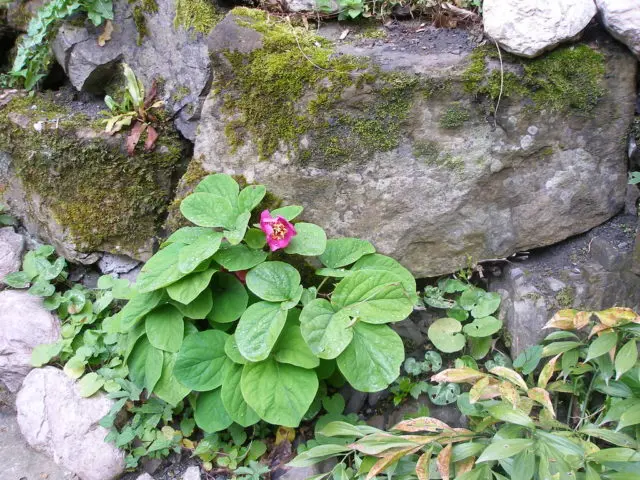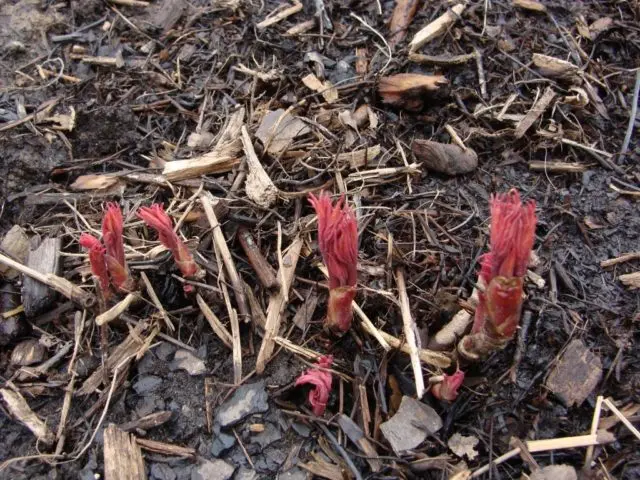Contents
The genus peony includes more than 3 dozen species, including rare ones, for example, the mountain peony, included in the Red Book. It grows in natural conditions, not introduced into the culture, but if desired, it can also be grown in the garden – if you follow the rules of agricultural technology.
Full description of the mountain peony
This species is endangered. The description of the mountain peony, a plant from the Red Book, was made in 1984. This is a perennial that is cold-resistant; in nature, it can withstand even the most severe cold.
The rhizome of the plant is located horizontally in the ground, the bush has a straight single stem, 0,3-0,6 m tall, ribbed, with a purple stripe along the ribs, with large red-crimson integumentary scales at the base. The leaves of the peony are green, with red-violet veins, obovate in shape, three times trifoliate, with a solid, not dissected edge. Wide – 18-28 cm in diameter. As you can see, the plant is different from the peonies that usually bloom in gardens, but it is also decorative in its own way.

Peony mountain has delicate flowers, often located among the stones
Where do mountain peonies grow?
Their range is the Far Eastern regions of Our Country, Khabarovsk, Primorsky Krai, Sakhalin Region. In addition to the Federation, this species grows in Korea, Japan and China. The plant can be seen in mixed forests – both among coniferous trees and in larches. Likes to grow in the shade, on gentle slopes or in floodplains.
The peony does not grow in large groups, does not form clearings or large clusters, grows mainly in single specimens or in small groups.
How a mountain peony blooms
Plants bloom in May. The flowers are simple, formed from 5-6 medium-sized petals, arranged in 1 row, light cream or yellowish, rarely pink or white. The flowers are 6-12 cm in diameter. The corolla rests on a green fleshy sepal. In the center there are up to 6 dozen bright yellow stamens with a purple base. The aroma of flowers resembles poppy.
After 2 months – in late July or early August, fruits with seeds ripen near the mountain peony. These are greenish-purple single leaflets, inside of which there are 4-8 brown seeds.
Why the mountain peony is listed in the Red Book
The mountain peony is included in the Red Book, as its number has greatly decreased and is still at a low level. And while there is no hope that the plants will independently restore their numbers to the levels when they are not threatened with extinction.
The value of mountain peonies for the ecosystem
Since everything in nature is interconnected, the disappearance of a population of any plant species entails a disruption in the entire system. The same applies to the mountain peony. Despite the fact that it does not serve as food for animals, does not form thickets that would noticeably affect the state of the ecosystem, it also has its value as an ornamental plant.

Mountain peonies decorate clearings in the forest, fill the spaces in young deciduous plantings
Reasons for the extinction of the species
The reasons for this state of the species are human activities: deforestation, which destroys the natural habitat of plants, forest fires.
This type of plant is also vulnerable because some people, walking through the forest, dig up the rhizomes to try to grow flowers in their area. But they do not always succeed, because the plant, if it takes root, grows poorly, because it is not in comfortable conditions. They also dig up the roots because they consider them medicinal, but this is a mistake; of many types of peonies, only medicinal and evasive peony (Maryin-root) have healing properties.
Reduces the number of peonies and the fact that people pluck their flowers for bouquets. In this case, the bush itself is harmed, and the plants cannot set seeds and multiply.
Measures for the protection of mountain peonies
In the Primorsky Territory and on Sakhalin, protected natural areas have been created where scientific, environmental and cultural activities are carried out aimed at protecting the mountain peony from destruction. In the regions, it is forbidden to pluck flowers and dig up the rhizomes of plants. All this should contribute to the fact that gradually the number of a beautiful flower will increase.
Is it possible to grow mountain peonies at home
Vegetatively propagated mountain peonies can theoretically grow in private gardens. But in practice this rarely happens. Basically, to increase their numbers, they are grown in botanical gardens, applying a scientific approach to this work. In suitable conditions, the mountain peony takes root, blooms.
How to propagate mountain peonies
This species reproduces in the same way as cultivated forms. Since it is impossible to completely dig out a bush, one option remains – to separate part of the root from it so that the plant does not die.
A piece of root should be such that a growth bud is present on it. After digging, you need to sprinkle the rhizome with earth so that the roots do not remain open. The best time for digging is the end of August or the beginning of autumn.
You can try another way: root a leaf cutting. Cut a part from the middle of the shoot, it should have an axillary bud. Plant the cutting in a moist loose substrate and root in a greenhouse at high humidity for about 1-1,5 months. After you can land in the garden.
Wild peonies, unlike garden peonies, reproduce well by seeds. At the same time, species characteristics are well preserved, therefore, for home breeding, you can grow a plant from seeds. To do this, you need to collect the fruits after they ripen on the bush. Grow seedlings from them, and then transplant them to a permanent place in the garden. The cultivation technology is the same as for cultivated peonies:
- Seeds are sown on a small bed in September-October.
- Before the onset of cold weather, it is covered with a layer of mulch.
- In the spring, as soon as the snow melts, with the onset of sunny weather, the shelter is removed.
Before transplanting, peonies from seeds should grow in the garden for at least 1 year. In the first few years of life, they most likely will not bloom.

The first years after planting, the sprouts need special care.
Planting and care
A place for a mountain peony in the garden must be chosen in such a way that it is in the shade or in partial shade, because it is in such conditions that it grows in nature. Dig up the area where the plant will be located and add humus and ash to it, especially if the soil is poor and has not been fertilized for a long time.
The mountain peony is transplanted in early spring or autumn – before or after the end of the growing season. The dimensions of the planting hole should exceed the volume of the roots of the planted seedling. You need to deepen it so that the growth buds are sprinkled with earth. Then water the seedling with water.
Caring for a mountain peony is simple: you need to water it often in the first month, make sure that the ground is always moist. After rooting, it is possible to water only in the heat, the rest of the time the plant will have enough moisture from the rains.
It is enough to feed 1 time per season – in early spring or autumn, using mineral or organic fertilizers. It is not necessary to overfeed, because of this the flowers will not be larger or more magnificent.
Preparation for winter should be carried out during the autumn work in the garden: cut off the withered stems, take them out and burn them, dig the bush lightly to give air to the roots, then sprinkle with foliage or any other type of mulch. However, if there is no warming, the plant should not freeze out, since it is much more resistant to cold than varietal peonies.
Pests and diseases
A mountain peony has stronger immunity than a domestic one, so it usually does not get sick with anything. But under favorable conditions for pathogens, some plants can be affected by fungal diseases, a little less often – by viral ones. After establishing the cause, it is necessary to carry out treatment: treat the bushes with drugs.
The same applies to pests. Most often, ants harm peonies. If insects are found on the buds, folk remedies should be used to combat them, for example, mix sugar or honey with boric acid and scatter near the bush. Attracted by the sweet bait, the ants will die.
You can spray the peony with an infusion of herbs, the smell of which pests do not like: bay leaf, parsley, tansy, wormwood, marigold, lavender, mint or garlic infusion. If this does not help, you must use chemical insecticides.
From garden pests, aphids can settle on plants. You can also fight it with folk methods: spray it with ash, soap or tobacco infusion. It is quite possible that once will not be enough to completely get rid of pests, so after a while (about 1,5 weeks) you need to repeat the spraying. As in the case of ants, it is advisable to use agrochemistry only in extreme cases.
Conclusion
Mountain peony is a rare plant protected by the state. That is why it is better to admire it in nature, but if you wish, you can grow it in your garden. The general principles of agricultural technology of this species coincide with the technology of growing garden peonies, so there should not be any particular difficulties.









